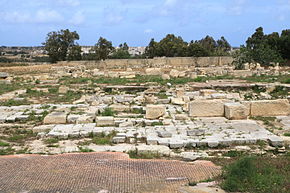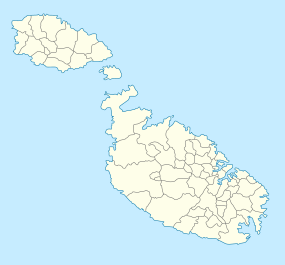Tas-Silġ

Ruins of Tas-Silġ
|
|
| Location | Marsaxlokk, Malta |
|---|---|
| Coordinates | 35°50′45.3″N 14°33′7.5″E / 35.845917°N 14.552083°ECoordinates: 35°50′45.3″N 14°33′7.5″E / 35.845917°N 14.552083°E |
| Type | Temple Village Monastery Fortification |
| Part of | Megalithic Temples of Malta |
| History | |
| Material | Limestone |
| Founded | c. 2500 BC |
| Abandoned | c. 870 AD |
| Periods |
Tarxien phase Bronze Age Phoenician Roman Byzantine |
| Site notes | |
| Excavation dates | 1963–1970 1996–2005 |
| Condition | Ruins |
| Ownership | Government of Malta |
| Management | Heritage Malta |
| Public access | By appointment |
Tas-Silġ is a rounded hilltop overlooking Marsaxlokk Bay, Malta, close to the city of Żejtun. Tas-Silġ is a multi-period sanctuary site covering all eras from Neolithic to the fourth century AD, and due to this it indicates to archaeologists several different layers of excavation. The site takes its name from the nearby Church of Our Lady of the Snows (Maltese: Knisja tal-Madonna tas-Silġ).
The area was first inhabited when a temple was built in the Tarxien phase of Maltese prehistory, sometime around 3000 to 2500 BC. Few remains from the original temple can be seen, but the scatter of megaliths over the hill suggests that there was a large complex with at least 3 temples and possibly a village surrounding it. A D-shaped setting of large blocks that was part of the four-apsed temple still exists as it was later incorporated into the other buildings on the site. In the Bronze Age, the temple was probably converted into a settlement, as had been done in other sites such as Borġ in-Nadur.
In the deepest layer of deposits, archaeologists found various artifacts including pottery, lithics, and a standing fat lady. From the Bronze Age layer, some sherds, stone tools and pottery were found. Other evidence from the Bronze Age consists of the large amount of handiwork.
After the Phoenicians took over Malta in around 700 BC, they built a Punic temple to Astarte incorporating upstanding remains of the earlier temple. A forward extension was added to the curved facade, and a monumental doorway flanked with two pilasters and topped by a huge stone slab was built. The sanctuary's importance eventually grew and a portico was added around 300 BC. Some parts of the temple, including a tower, might have been designed as a fortification to help defend it from possible invaders.
A threshold slab pierced by three libation holes that divided the eastern part of the temple and the western side, as well as a series of ashlar foundation walls for a platform built to the south of the main sanctuary still exist. Around this area, various remains were found including pottery, ash, animal bones, coins and shreds. Some of these shreds have votive inscriptions. It is claimed that the Cippi of Melqart might have originally been at the Tas-Silġ temple, but their origin is disputed.
...
Wikipedia

